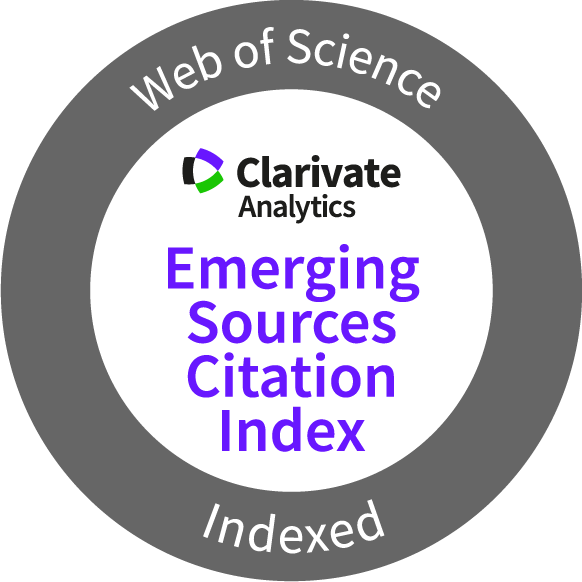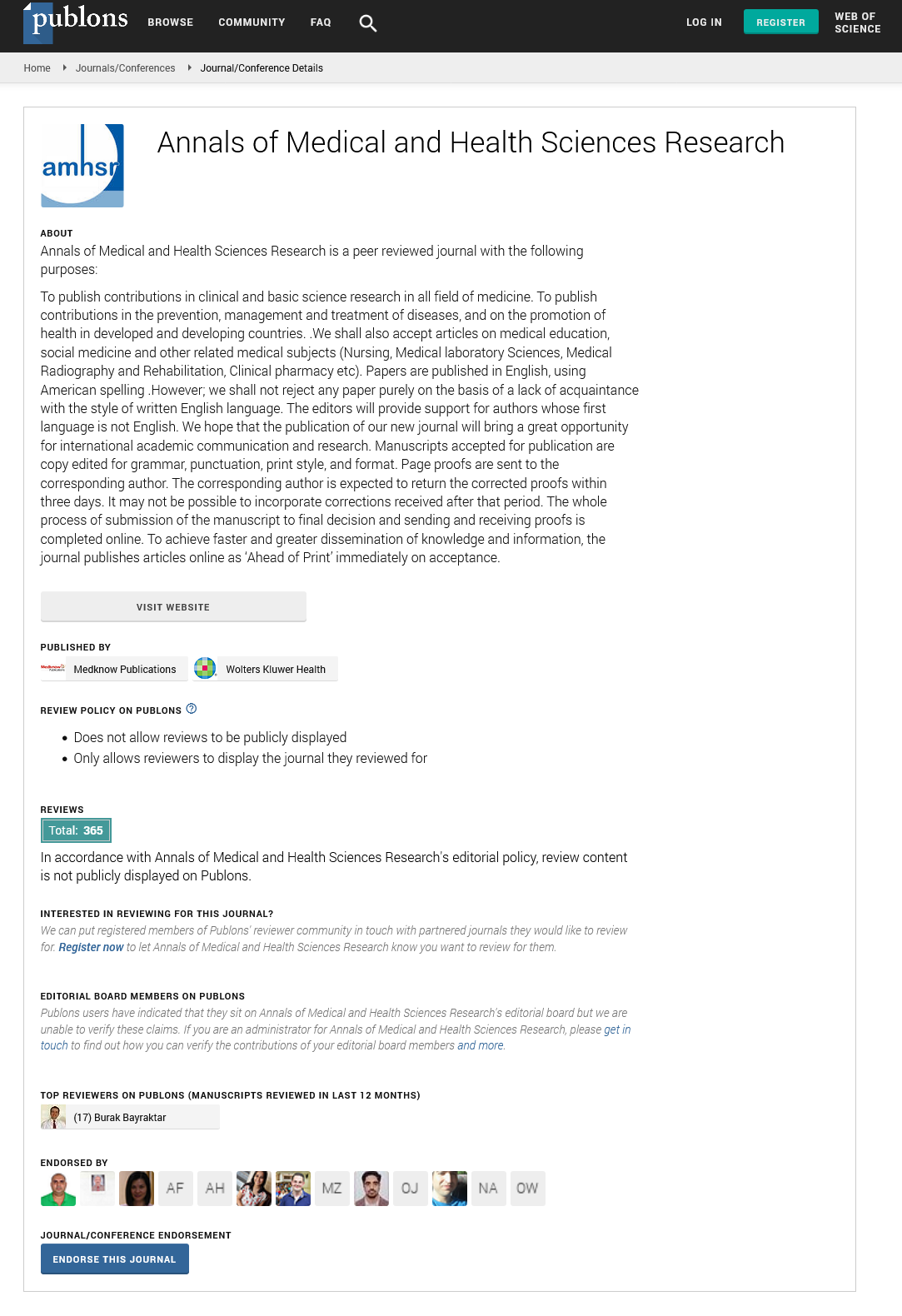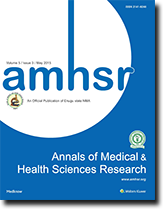Is There an Association between Ocular Pathology and Congenital Heart Defects in Patients with Down Syndrome?
Received: 12-Aug-2021 Accepted Date: Aug 26, 2021 ; Published: 29-Jul-2021
This open-access article is distributed under the terms of the Creative Commons Attribution Non-Commercial License (CC BY-NC) (http://creativecommons.org/licenses/by-nc/4.0/), which permits reuse, distribution and reproduction of the article, provided that the original work is properly cited and the reuse is restricted to noncommercial purposes. For commercial reuse, contact reprints@pulsus.com
Abstract
Background: Additional chromosomal material dictates the severity of craniofacial dysmorphism, intellectual disability and associated pathologies, mostly Congenital Heart Defects (CHD). High geographical and seasonal fluctuation in CHD has been reported. The presence of type VI collagen both in ocular and cardiac tissue may be the reason for an association between ocular and cardiac disease. Methods & Materials: We conducted a prospective study on 54 patients with Down syndrome. Patients were recruited from Genetics Department, between December 2018 and January 2020. All patients underwent a complete eye examination by a general ophthalmologist and a cardiologic evaluation. Results: Congenital heart defects were present in 57% of the DS patients. The most common defect was the interatrial communication present in 7 (14%) of the patients followed by the Fallot tetralogy and a defect in the atrioventricular sept in 6 patients (12%). Astigmatism was the most frequent cause of decreased visual acuity in DS patients with congenital heart. Conclusion: The results of our study did not identify specific associations, with statistical significance, between ophthalmic and cardiac pathology in patients with DS
Keywords
Congenital heart defects; Ocular disease; Astigmatism
Introduction
Minor congenital ocular anomalies are most common in patients with Down Syndrome (DS). [1]
Due to the presence of extra genetic material, children with 21 trisomy have associated systemic pathologies.
The amount of additional genetic burden dictates the severity of craniofacial dysmorphism, intellectual disability and associated pathologies. [2]
The diagnosis of DS consists of a constellation of more than 80 major or minor markers. [3]
The most commonly encountered pathologies are cardiovascular (40%-50%), gastrointestinal (4%-10%) and childhood leukemia. [4]
Congenital Heart Disease (CHD) is the most important cause of morbidity and death in patients with DS in the first 2 years of life worldwide.[5-7]
High geographical and seasonal fluctuations in the incidence of CHD have been reported. [8]In Europe, by far the most frequent CHDs in DS patients are atrioventricular septal defects. [9-10]
A high incidence of ocular abnormalities has prevailed in all studies that describe the prototype of the patient with SD.[11-13]
Eyelid malformations and refractive errors were most often described in these patients. [14-15]
Even if most of the ocular markers present in DS patients are minor or without significant importance, their presence alone or in association with other malformations can offer important clues. Typically, in DS all ocular contents and their adnexa can present anomalies. [16]
The presence of type VI collagen in cardiac tissue (COL6A1) could also be the cause of a certain association between ocular and cardiac anomalies in patients with DS. [17]
The aim of the study was to analyze the ocular profile of DS patients that suffer from a congenital heart anomaly.
Materials and Methods
This prospective study was based on the DS patient’s registry from a Genetics Department between December 2018 and January 2020. The diagnosis of DS was established after clinical examination and was confirmed in all cases through a cytogenetic exam (karyotype and/or fluorescence in situ hybridization). All data regarding the patient’s cardiac anomalies was obtained from their medical history.
Study inclusion criteria were: DS patients between 1 and 18 years old on whom a complete ophthalmological assessment could be performed.
Exclusion criteria were: patients for whom we did not have a complete cardiac history.
Ethical consideration
The study was approved by the Ethical Council of the Hospital. Informed parental consent was required for each assessed patient.
The first step of the clinical examination of the eye included: visual assessment, refraction and assessment of the ocular motility.
The visual acuity and refraction (with and without cycloplegia) were measured according to patient age and intellectual disability. In a nonverbal patient, vision was evaluated in terms of fixation (eccentric or central fixation) and duration. In verbal patients it was tested using optotypes (Snellen chart, tumbling E chart). Cycloplegia was carried out in all patients through instillation of 3 drops of Tropicamide 1%. According to age and compliance, refraction was measured with an auto refractometer (Tomey RC-800 Auto Ref/K) or PlusOptix A12C or streak retinoscopy in non-compliant patients.
The ophthalmic assessment included the inspection and slit lamp examination of the ocular adnexa. The ruler was used to
measure the intercanthal and interpupillary distance, necessary parameters for establishing the proper diagnosis of hypertelorism or of telecanthus. The vertical palpebral fissure was measured using the cornea superior eyelid index or the pupil superior eyelid margin index. The eyelash line and Meibomian glands line were assessed using the slit lamp. A gross examination of the conjunctiva and the lacrimal system was made in a well-lighted room and after that through magnification by means of a slit lamp.
The eyeball assessment was performed from anterior to posterior, first time in miosis and after that in mydriasis (Tropicamide 1%). The fundus exam was performed using indirect ophthalmoscopy when we had good compliance or the ophthalmoscope for less compliant patients (Welch Allyn Panoptic). The optic nerve head and disc, macula with fovea, the periphery of the macula and retinal vessels were followed from the emergence to the periphery.
All patients in the study benefited from a detailed systemic clinical examination and those older than 3 also had an IQ test.
Results
We examined a total of 54 patients, 25 female (46%) and 29 males (54%). The mean age of the study participants was 8.78 years.
Congenital heart disease was present in 31 (57%) of the DS patients. The most common defect was the Atrial Sept Defect (ASD) present in 7 (14%) of the patients followed by the Fallot tetralogy and the Atrioventricular Sept Defect (AVSD) in 6 patients (12%), tricuspid insufficiency in 5 (10%) patients, interatrial and intraventricular communication in 4 (8%) patients and 3 patients presented with other birth defects. The category of other birth defects includes arterial canal patency, pulmonary stenosis and heart failure of other causes [Table 1].
| Congenital cardiac disease | Nr. | % Patients |
|---|---|---|
| Atrial sept defect | 7 | 14 |
| Fallot tetralogy | 6 | 12 |
| AtrioVentricular Sept Defect (AVSD) | 6 | 12 |
| Tricuspid insufficiency | 5 | 10 |
| Interatrial and Intra Aventricular Communication (IAC) | 4 | 8 |
| Other birth defects | 3 | 6 |
| Total | 31 | 58.49 |
Table 1: Prevalence of the congenital heart disease
The most frequent cause of decreased visual acuity in DS patients with congenital heart disease was astigmatism (35 eyes) [Table 2]. Because there have been many cases of anisometropia, the total number of eyes with a refractive error
has been taken into account. Astigmatism was equally well represented (34 eyes) among patients with DS but without congenital heart disease.
| Ocular pathology | Nr of affected eyes in patients with CHD | Nr of affected eyes in patients without CHD |
|---|---|---|
| Astigmatism | 35 | 34 |
| Hyperopia | 30 | 28 |
| Myopia | 27 | 11 |
| Esotropia | 10 | 6 |
| Blepharitis | 7 | 3 |
| Lens opacities | 6 | 4 |
| Brushfield spots | 5 | 6 |
| Nystagmus | 4 | 2 |
Table 2: Ocular pathology in DS patients
The same number of eyes were diagnosed with hyperopia in both those who suffer from CHD and those without CHD. Myopia had a higher prevalence among those with CHD, 27 eyes versus 11 eyes in those without CHD.
Esotropia was the only ocular deviation detected in patients in our group. 10 DS patients with CHD were diagnosed with an ocular deviation and also 6 DS patients without CHD [Table 2].
Inflammation of the eyelid margin (blepharitis) was present more often in patients with CHD, 7 vs. 3 patients without CHD.
Ocular examination revealed 6 patients with CHD and lens opacities and 4 patients without CHD and lens opacities. Brushfield spots were present in 6 patients with DS and without CHD and in 5 patients with CHD [Table 3].
| Cardiac malformations | Nr patients with myopic astigmatism | Nr patients with hyperopic astigmatism |
|---|---|---|
| Atrial sept defect | 7 | 0 |
| Tricuspid insufficiency | 5 | 3 |
| Fallot tetralogy | 5 | 2 |
| Atrioventricular Sept Defect(AVSD) | 1 | 2 |
| Interatrial communication | 1 | 3 |
| Other birth defects | 1 | 3 |
| Total | 17 | 13 |
Table 3: Distribution of astigmatism in patients with CHD
Nystagmus was present in 4 patients with CHD and 2 patients without CHD.
Regarding the type of astigmatism in patients with CHD, the myopic type prevails over the hyperopic one. Most often the myopic type has been associated with IAC, 7 patients out of a total of 17.
All refractive errors and ocular pathology were correlated with each cardiac malformation using Fischer’s exact test, but the results were without statistical significance (p>0,05).
Except for the Brushfield spots, any ocular pathology found in patients with DS was more common in those with CHD.
Discussion
It has been shown by other authors that there is a correlation between certain refractive errors, most often myopia or astigmatism, and some cardiac anomalies. [18-20]
The data obtained in our study showed that there is no correlation with statistical significance (p>0,05 calculated with exact Fischer test) between a cardiac malformation and a certain refractive error, ocular deviation (esotropia was the only ocular deviation present in our patients) or other ocular pathology which could cause decreased visual acuity or a decrease in the quality of life of these patients.
Atrial sept defect, Fallot tetralogy and atrioventricular sept defect were the most common CHD found in our patients results, in concordance with other studies from Europe and Africa. [21,22]
In contrast with the results of our study, the group of DS studied by Afifi et al. revealed a correlation between CHD and myopia in subjects with DS. The results were interpreted by the author as a genetic feature found in the inhabitants of the Nile region riverand the city of Cairo. [20]
Similar with Bromham, Morreale-Bubella et al. and Afifi studies [19,20,23] myopia was more common in patients with CHD than in those without CHD. Al-Jarallah et al. mention the role of consanguinity in DS population from Saudi Arabia and Egypt. [24,20] The explanation would be the presence of a copy of chromosome 21 in cells that could increase the expression of some genes. Other hypothesis launched by Bromham would be that genes located on chromosome 21 participate in the development of the cardiac system. [23]
The genetic polymorphism involved in cardiac pathology could explain a certain association with myopia.
Ljubic et al. found no statistical significance between any refractive error, strabismus or nystagmus with certain CHD. The explanation for these results may be the small number of subjects studied with DS and CHD. The authors also described an association of statistical significance that has not been cited in other studies, the combination of Brushfield spots and epiblepharon with CHD. In contrast, in our study, Brushfield spots were the only DS ocular marker less common in patients with DS and CHD. [25]
Conclusion
The results of our study did not identify specific associations, with statistical significance, between ophthalmic and cardiac pathology in patients with DS. However, it is important to perform an early ophthalmic screening in patients with DS with or without CHD.
REFERENCES
- Nemes-Dragan IA, Dragan AM, Bembea M. Minor congenital ocular anomalies assomatic markers in genetic disorders. Ro J Pediatr. 2020; 69:297-304.
- Shapiro BL. Whither Down syndrome critical regions? Hum Genet. 1997;99(3):421-3.
- Reeves RH, Baxter LL, Richtsmeier JT. Too much of a good thing: Mechanisms of gene action in Down syndrome. Trends Genet. 2001;17(2):83-8.
- Antonarakis SE, Lyle R, Dermitzakis ET, Reymond A, Deutsch S. Chromosome 21 and down syndrome: from genomics to pathophysiology. Nat Rev Genet. 2004;5(10):725-38.
- Stoll C, Alembik Y, Dott B, Roth MP. Study of down syndrome in 238,942 consecutive births. Ann Genet. 1998;41:44-51.
- Freeman SB, Taft LF, Dooley KJ, Allran K, Sherman SL, Hassold TJ, et al. Population-based study of congenital heart defects in Down syndrome. Am J Med Genet. 1998; 80(3):213–217.
- Vida VL, Barnoya J, Larrazabal LA, Gaitan G, de Maria Garcia F, Castaneda AR. Congenital cardiac disease in children with down’s syndrome in Guatemala. Cardiol Young. 2005;15(3): 286–290.
- Narayanan DL, Yesodharan D, Kappanayil M, Kuthiroly S, Thampi MV, Hamza Z, et al. Cardiac spectrum, cytogenetic analysis and thyroid profile of 418 children with down syndrome from South India: a crosssectional study. Indian J Pediat. 2014;81(6):547–551.
- Barlow GM, Chen XN, Shi ZY, Lyons GE, Kurnit DM, Celle L, et al. Down syndrome congenital heart disease: A narrowed region and a candidate gene. Genet Med. 2001;3(2):91-101.
- De Rubens FJ, del Pozzo MB, PablosHach JL, Calderon JC, Castrejon UR. Heart malformations in children with Down syndrome. Rev Espanola Cardiol. 2003;56(9): 894–899.
- Lowe RF. The eyes in mongolism. Br J Ophthalmol. 1949;33(3): 131–74.
- Jaeger EA. Ocular findings in down’s syndrome. Trans Am Ophthalmol Soc. 1980;78:808–45.
- da Cunha RP, Moreira JB. Ocular findings in down’s syndrome. Am J Ophthalmol. 1996;122(2):236–44.
- Nemes-Dragan IA, Dragan AM, Bembea M. Clinical aspects and optical coherence tomography in diagnosis and follow-up of down syndrome patients. Proceeeding of 5th Medical Genetics Congress with International Participation.2018.
- Creavin AL, Brown RD. Ophthalmic abnormalities in children with down syndrome. J Pediatr Ophth Strab. 2009;46 (2):76–82.
- Krinsky-McHale SJ, Silverman W, Gordon J, Devenny DA, Oley N, Abramov I. Vision deficits in adults with down syndrome. J Appl Res Intellect Disabil. 2014;27(3):247-63.
- Davies GE, Howard CM. Genetic variation in the COL6A1 region is associated with congenital heart defects in trisomy 21 (Down's Syndrome). Ann Hum Genet. 1995;59(3):253-269.
- Al-Jarallah AS. Down's syndrome and the pattern of congenital heart disease in a community with high parental consanguinity. Med Sci Monit. 2009;15(8):CR409-12.
- Morrealle-Bubella R, Piccione M. Correlation between ophthalmic disorders and congenital cardiac disease in children with down syndrome. Int J Ophthalmol. 2017;10(1):231-233.
- Afifi HH, Abdel Azeem AA. Distinct ocular expression in infants and children with down syndrome in Cairo, Egypt: Myopia and heart disease. JAMA Ophthalmol. 2013;131(8):1057-1066.
- Benhaourech S, Drighil A, Hammiri AE. Congenital heart disease and Down syndrome: Various aspects of a confirmed association. Cardiovasc J Afr. 2016;27(5):287-290.
- Nisli K, Oner N, Candan S, Kayserili H, Tansel T, Tireli E, et al. Congenital heart disease in children with Down's syndrome: Turkish experience of 13 years. Acta Cardiol. 2008;63(5):585-9.
- Bromham NR, Woodhouse JM, Cregg M, Webb E, Fraser WI. Heart defects and ocular anomalies in children with Down's syndrome. Br J Ophthalmol. 2002;86(12):1367-8.
- Jarallah A. Down's Syndrome and the pattern of congenital heart disease in a community with high parental consanguinity. medical science monitor. Int J Clin Exp Med. 2009;15(8):CR409-12.
- Ljubic A, Trajkovski V, Tesic M, Tojtovska B, Stankovic B. Ophthalmic manifestations in children and young adults with Down syndrome and congenital heart defects. Ophthalmic Epidemiol. 2015;22(2):123-9.




 The Annals of Medical and Health Sciences Research is a monthly multidisciplinary medical journal.
The Annals of Medical and Health Sciences Research is a monthly multidisciplinary medical journal.